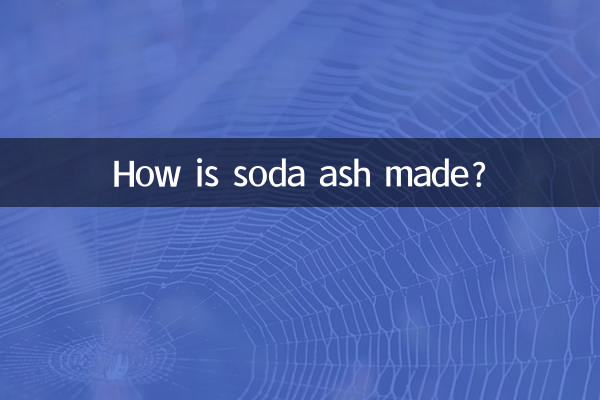How is soda ash made?
Soda ash (sodium carbonate, Na₂CO₃) is an important chemical raw material and is widely used in glass, detergent, paper and other industries. This article will introduce in detail the production method, production process and related data of soda ash to help readers fully understand the production process of this chemical.
1. Production method of soda ash

At present, there are three main production methods of soda ash: Solvay method (ammonia-alkali method), Hou's alkali production method and trona ore processing method. Here is a comparison of the three methods:
| production method | raw material | reaction principle | Advantages and Disadvantages |
|---|---|---|---|
| Solvay method | salt, limestone, ammonia | NaCl + NH₃ + CO₂ + H₂O → NaHCO₃ + NH₄Cl | The process is mature, but the by-product calcium chloride is difficult to handle |
| Hou's method of making alkali | Salt, ammonia, carbon dioxide | NaCl + NH₃ + CO₂ + H₂O → NaHCO₃ + NH₄Cl | High utilization rate of raw materials and by-products can be recycled |
| trona ore processing method | trona ore | Na₂CO₃·NaHCO₃·2H₂O → Na₂CO₃ | Low cost, but dependent on mineral resources |
2. Solvay process (ammonia-alkali process) production process
The Solvay process is the most commonly used soda ash production method in industry. Its specific process is as follows:
1.limestone calcined: Limestone (CaCO₃) decomposes at high temperatures to produce carbon dioxide (CO₂) and quicklime (CaO).
2.Ammonia salt water preparation: Pass ammonia gas (NH₃) into saturated salt water to form ammonia salt water.
3.carbonation reaction: Pass carbon dioxide into ammonia salt water to generate sodium bicarbonate (NaHCO₃) and ammonium chloride (NH₄Cl).
4.Filtration and Calcination: Filter and calcine sodium bicarbonate to obtain soda ash (Na₂CO₃) and carbon dioxide (CO₂).
5.Ammonia recovery: Ammonium chloride reacts with quicklime to recover ammonia for recycling.
3. Key data of soda ash production
The following are key data for Solvay’s process for soda ash production:
| project | numerical value |
|---|---|
| reaction temperature | 30-50℃ |
| reaction pressure | normal pressure |
| sodium bicarbonate solubility | 9.6g/100g water (20℃) |
| Calcination temperature | 200-300℃ |
| Soda ash yield | ≥90% |
4. Application fields of soda ash
Soda ash is a multifunctional chemical whose main application areas include:
1.glass manufacturing: Soda ash is one of the main raw materials for glass production and can lower the melting point of glass.
2.Detergent: Soda ash has good decontamination ability and is often used in washing powder and detergents.
3.paper industry: Soda ash is used in the bleaching and deinking process of pulp.
4.chemical industry: Soda ash is an important raw material for the production of other chemicals (such as sodium silicate, sodium phosphate).
5. Environmental protection issues in soda ash production
The traditional Solvay process for producing soda ash produces a large amount of calcium chloride as a by-product, which puts a certain amount of pressure on the environment. Modern industry gradually reduces pollution emissions through improved processes (such as Hou's alkali production process) and resource recycling. The following are environmental protection measures in soda ash production:
1.Waste utilization: Calcium chloride is used for road frost protection or construction materials.
2.wastewater treatment: Treat production wastewater through neutralization, precipitation and other methods.
3.energy recovery: Use the waste heat in the calcination process to generate electricity or heat.
Through the above introduction, I believe everyone has a deeper understanding of the production methods, processes and applications of soda ash. As a basic chemical product, the optimization of soda ash's production process and the advancement of environmental protection technology will continue to promote the sustainable development of the industry.

check the details

check the details